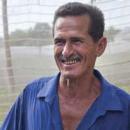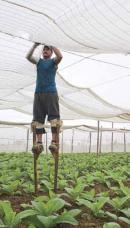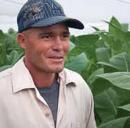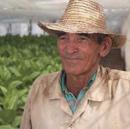Vuelta Abajo. Pinar del Rio
The Birthpla ce of Habano
When it comes to Cuba’s many beautiful places, this province is a standout. Two of its most famous locations are the Viñales Valley – declared World Cultural Landscape – and the fields of Vuelta Abajo, a genuine postcard that depicts the relationship between man and the environment, especially when it’s carpeted with tobacco plants later in the year and into the early going of the next.
Pinar del Rio is Cuba’s easternmost province. Its capital is 79 miles from Havana, while the tobacco plantations of Vuelta Abajo (D.O.P., Spanish acronym for Denomination of Origin) are barely a 30-minute drive from the province’s main city, down the road that leads to San Juan y Martinez and San Luis, the epicenter of harvested leaves for Habanos. The features of the soil, coupled with the local climate, deep-rooted culture in the handling of plantations and the growers’ centennial tradition, combine in a very particular fashion in this region, recognized for centuries as the land of the world’s finest black tobacco and birthplace of the Habano, let alone the only spot where the origin defines its own essences. The region that harbors the villages of San Juan y Martinez and San Luis is known as Vuelta Abajo, yet it’s important to know there are also some differences there in terms of soils and natural conditions. Therefore, there are districts, extensions or locations larger than others. Some of them are home to the so-called Vegas de Primera (Top-Class Plantations), a category certified by the Tobacco Research Institute for those lands in which the leaves for Habanos are grown. These are plantations with working and growing styles of their own, in which planters are highly skilled and successful, like some sort of prodigious growers or rural patriarchs who know all the secrets of both the field and tobacco. There are two ways of growing tobacco, so on both sides of the road visitors can make out sun-grown plants – they stand out for their bright green hues – and others covered by thin white cheesecloth to protect them from the sweltering sun. This method fosters the growth of the leaves and prevents them from getting fibrous, coarse or too thick. The shade-grown plantations produce wrapper, very delicate and soft leaves used by cigar rollers as the finishing layer for the elegant presentation of these centuries-old kings of good taste and glamour, a masterpiece resulting from the patient dedication and experience of Cuban cigar makers on the field and in the factories. The sun-grown plantations, for their part, embrace larger lands and provide different leaves for the filler and binder of a Habano – the mixture’s preliminary wrappings. In each case, this process is based on an ancient dosage that singles out every traditional Habano brand and its several vitolas.
Sun-Grown Tobacco for Wrapper Exposed to sunshine and heat, the texture of tobacco leaves can be surlier or coarser. But when sunlight is filtered through and the leaves are protected from high temperatures, they grow bigger and remain both delicate and thin. El traslúcido cobertor textil (reduce en aThe cheesecloth – it cuts down on approximately 30 percent of direct sunlight – used in shade-grown tobacco plantations guarantees ideal conditions for the end usage of those leaves: the wrapper. It’s all about a very demanding growing method – there are no more than 360 tobacco planters in Vuelta Abajo dedicated to this particular process – and there’s no doubt this is the most valuable leaf of a Habano, the outcome of a thorough and hardworking plant-by-plant and leaf-by-leaf process in the field that brooks no reckless disregard or delays. “It’s a hard work from dawn to dusk. Therefore, soil preparation, the transplant of the seedlings, the digging, the hoeing, the cheesecloth covering, the tying up of the plants, the cleaning, the watering or any other thing must be done in due time when it comes to shade-grown tobacco. Each thing at its right time, otherwise stay away from that method,” says Yosvany Concepcion Alonso, a tobacco planter from Palmarito. “It’s hard and rewarding at the same time, so if you want results you better get down to it,” he adds. There seems to be no other way. According to some estimates, each plant in a plantation must be visited for a number of different reasons some 150 times during the growing and harvesting process. The removal of unwanted buds to make the leaves grow bigger takes up a considerable chunk of those calls, and something similar happens with the collection of leaves, a layer-by-layer process that starts from the ground up (mañanita, libre de pie, uno y medio, primer centro ligero, segundo centro ligero, primer centro fino, segundo centro fino, centro gordo and corona in that order) and can stretch out for several weeks. Yosvany takes care of 60,000 plants of shade-grown tobacco in his plantation, so he’ll pay a staggering 3 million visits through a three-month period. The fact of the matter is that shade-grown tobacco – given its final destination as the Habano’s visible outer layer – requires planters to take so much care. At the end of the day, each and every leaf counts, though only the biggest and thinnest ones are handpicked for the coveted wrapper. An opinion similar to Yosvany’s comes to us from both seasoned and wet-behind-the-ears planters that we met during our recent trip to Pinar del Rio. Fidel Regalado, an outstanding planter from Obeso – a district of San Juan y Martinez – and with fifteen years of experience in this crop, says jokingly that “anyone willing to drive boredom away has quite a lot to do around here these months.” The same is voiced by Alberto Martinez and Santiago Piñeira Rodriguez as they speak with the classic humbleness of hicks who shun grandeur and don’t pick their words to refer to their daily jobs, no matter how toilsome the task might actually be. A precious moment during the trip came from Hiroshi Robaina, the grandson of larger-than-life planter Alejandro Robaina. Hiroshi says he’s got his mind made up to keep his plantation in San Luis, Pinar del Rio – the family tradition kicked off back in 1845 and his grandfather raised it to the highest standards – as a paradigmatic example of what tobacco planters in Vuelta Abajo can actually do.
Scent and Taste Grow under the Sun The aroma and the strength of the Habano are the result of direct sunlight and the soils of Vuelta Abajo, though the legit connoisseurs believe these basic features are clearly present in San Juan y Martinez and its uncovered plantations, in which Hoyo de Monterrey tops the list of the best-known and most-photographed fields of all. These plantations provide Habanos with the filler – medio tiempo, seco, volado and ligero – and the binder, whose mixture or blend, contributed in different portions, adds different scents and tastes, and chips in more or less strength, depending on the cigar brand they are going to be used in. Veteran tobacco planters or seasoned cigar sellers usually insist on the exceptional qualities of San Juan’s sandy, loose and mineral-laden soils that nourish the little roots with all the nitrates and nutrients for the leaves to start growing under bright green hues. This is no doubt the beginning of long journey. Relative humidity in the neighborhood of 70 percent and much milder temperatures during the early months of the year are decisive complements that no other place on the island nation – not even in the whole wide world – has to offer. Those are one-and-only conditions that give way to top-of-the-line raw materials used in the hand-rolling of Habanos. In that combination of factors lies the foundations for the matchless qualities and priceless value of Vuelta Abajo’s sun-grown black tobacco. “I tell you that the lousiest tobacco you can find around here – and I don’t know if that can be possible – is always going to be a whole lot better than the finest tobacco from anywhere outside these lands,” says planter Mario Puentes Guevara, the proud owner of a farm that stands just a few yards from the road, looking like a picture-perfect snapshot. Just another enchanting view is offered by the colossal plantation that belongs to Jose Antonio Fernandez, son and grandson of tobacco planters with over half a century of experience under his belt. This seasoned tobacco grower believes those lands are his main source of inspiration, “regardless of the hard work and the sweat of your brow.” The landscape is a nonstop green sea that meets the eye. How many plants do you have in your plantation? I asked him. Without thinking twice, he told me there are “only 141,000” – though it’s quite a whopping figure to me. The El Rosario farm is also in San Juan y Martinez, run by Maximo Perez Maseda. “The latest news I can break to you about this harvest is that I’ve grown my plantation using the Zero Tilling method that, right as the mavens at the Soil Institute had forewarned me, it’s highly positive in the sense of how much land work can be saved, I mean, the plowing and preparation of the fields, that always lead to some sort of erosion. On the other hand, this method enriches the soils organically and leaves tremendous benefits in terms of nutrients.” This is a method that has been tried out in Vuelta Abajo at small scales, yet Maximo has had the chance of applying it in a 230,000-plant field. It consists of avoiding any plowing of the land as long as there’s no real need to lift the burrow ridge. At the same time, the growing of tobacco is alternated with other crops, such as corn and a creeping plant called velvet bean. A few weeks before the tobacco seedlings are planted, the other crops’ stubbles cover the field as organic fertilizer, eventually nourishing the soils when they go to waste. This is a practical expression of a line of work developed by the Tobacco Institute, in coordination with other institutions that look after the quality and exceptional value of Vuelta Abajo’s soils and that give top priority to the wise blend of traditions and the best experiences derived from thorough research studies on plague control, species improvement, as well as the sanitary and farming handling of tobacco plantations. “This is progress at its best, so we’re going to have good tobacco for a mighty long time,” Maximo says. Before that, nature has already done its own share. After his Short Happy Life in the field, as Hemingway called one of the stories in his The Snows of Kilimanjaro book, the collected leaves should be sewed together alongside wooden rods and rest in curing barns that dot the region of Vuelta Abajo. It’s in those barns where the leaves endure their first fermentation before setting out on a long voyage until they are finally rolled into amazing Habanos.












































